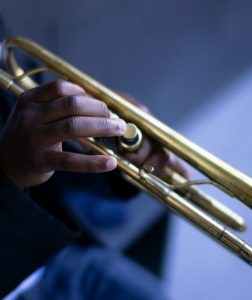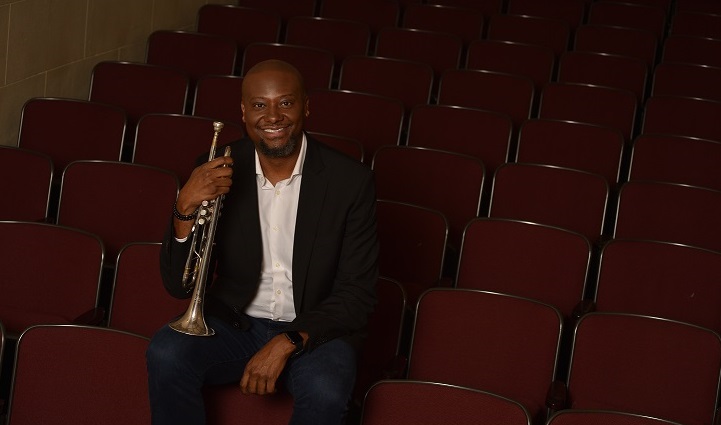How a Classical Musician Directed a Jazz Band
You don’t have to choose between classical and jazz. If you are a trained classical instrumentalist, leap into the world of jazz!
When I began my first semester of student teaching in instrumental music, I was immediately thrust into the world of jazz band. At my assigned high school, the jazz band was the only ensemble that wasn’t preparing for band festival, so it was the one that I could teach.
My prior experience with jazz included studying jazz theory as part of a classical theory course and playing on stage at the local jazz club… once. I was barely equipped to comp, conduct or analyze chords in jazz, let alone teach someone else how to. And that’s exactly why I’m writing this article.
I realized that there’s a high likelihood that other young instrumental music educators are inheriting a jazz band along with concert bands. And while our professors do their best, they can’t cover everything in a brief four years.
I hope my experience will provide some help if you find yourself in front of a jazz band.
Jazz Subgenres
 Before I dive into directing tips, let’s look into the most common subgenres of jazz that I taught: big band Latin, swing and blues.
Before I dive into directing tips, let’s look into the most common subgenres of jazz that I taught: big band Latin, swing and blues.
A quick side note: Jazzers call music “charts” rather than “scores.” I think the culture around jazz is extremely interesting — it is so refreshing and fun!
Latin jazz is jazz with a side of Latin American rhythms. It is infused with polyrhythms and instruments from places like the Caribbean and Cuba (think “The Girl from Ipanema”). As catchy and exciting as these songs are, I wouldn’t recommend starting with just any Latin jazz chart — they can be very difficult rhythmically!
Swing was developed in the 1920s and ‘30s. It often uses a big band or jazz orchestra instrumentation, which includes trumpet, trombone, saxes and a rhythm section. One example of a swing tune is “Sing Sing Sing” by Benny Goodman. Swing charts are a great place to start for new jazz band directors because they are straightforward.
Blues and jazz go hand in hand even though blues came before jazz. It is often integrated into today’s jazz bands. Blues-jazz charts integrate 12-bar pattern and often have a lot of call and response.
Other jazz genres that I have taught include cool jazz and ragtime. Bebop is a well-known genre, but you likely won’t get into it too much at the high school level because the chord changes are extremely fast and tricky!
CHECK IT OUT: The YAS-26 Standard Alto Saxophone
Immerse Yourself
One thing that really helped me feel more comfortable in front of the jazz ensemble was immersing myself in the genre. I attended as many university jazz nights as I could in my spare time. Even if you don’t play saxophone, guitar or keys, you can bring your instrument into the mix and start transposing. I once joined a saxophone section on piccolo. All I had to do was transpose down (or read it in bass clef and add some flats).
Informed listening will help both you and your band get a better feel for jazz. Start with some jazz greats like Duke Ellington, Miles Davis, Louis Armstrong, Dizzy Gillespie, John Coltrane and Charlie Parker. Daily listening will also help your players improve their phrasing and soloing, and help them to widen their palette of tone colors!
Jazz Conducting
 When I first stepped in front of a jazz band, a lot of questions flooded my mind: How do I move? How do I cue instrumentalists? What kind of energy should I embody for these students?
When I first stepped in front of a jazz band, a lot of questions flooded my mind: How do I move? How do I cue instrumentalists? What kind of energy should I embody for these students?
Conducting a jazz band is a completely different ballgame from a concert band. It feels much more relaxed because basically, the band can run itself. I found that jazz conductors typically use only one hand.
In order to cue sections or soloists, you use a pointed, stabbing motion. When I do this, I tell myself, “And, NOW!” Jazz conductors need to have a natural sense of where beats 2 and 4 are all the time. Be prepared to snap on 2 and 4 … a lot!
Once the band settles into a chart and can run on “autopilot,” start asking yourself how you can act as a visual element if that’s your preferred style. In jazz, there are two schools of conductors: 1) those who are either extremely present and showy and 2) those who are laid-back and only act when the band needs them.
Setting Up the Band
There are many ways to set up a jazz band, but this is how I did it: Saxes in the front, then trombones, then trumpets. The pianist, bassist and guitarist were to the side — on the left side — and in close proximity to one another. The drummer was at the back left of the ensemble, so everyone can hear the heartbeat of the band.
Another way to arrange the players is in a “V” pattern, with trumpets and trombones on the left, saxes on the right, and rhythm in the middle.
Many directors prefer to place the lead players (first chairs) in the middle of the band so the other instrumentalists can hear them and follow. Many jazz bands also use risers for their trumpets. If your program can’t afford risers and you’re finding that the high brass isn’t coming through clearly enough, have the trumpets stand.
Recruiting Rhythm Section Members
It’s common to need to replace your rhythm section members (drums, bass, piano) or recruit new ones. There is typically only one bass player, one percussionist and one pianist, so if you lose one, you’ll need to get another — and quick!
Here are some tips I have on making that happen:
- Start with students who can already read sheet music — Sometimes, the clarinetist (or other winds player) who also happens to play drums in a rock band can fit the bill.
- Talk to your students — If you conduct other ensembles, such as a symphonic band, ask your students if they know anyone who takes lessons on rhythm instruments.
- Get involved with local one-on-one teachers — get in touch and stay in touch with private music instructors in your area for possible replacement rhythm section players.
- Open up your practice space — leave the practice rooms open to your entire school instead of just band members. This will allow you to do a pre-audition of sorts by listening to the musicians practice.
Popular Pieces to Try Out
 If you’ve been asked to begin directing a jazz band, you’ll need some repertoire. Pepper in some rock or pop tunes like “Eye of the Tiger,” but here is a short list of standards and charts to get you started:
If you’ve been asked to begin directing a jazz band, you’ll need some repertoire. Pepper in some rock or pop tunes like “Eye of the Tiger,” but here is a short list of standards and charts to get you started:
- “Blue Bossa”
- “C Jam Blues”
- “Autumn Leaves”
- “Lullabye of Birdland”
- “Take the A Train”
- “Stella By Starlight”
You’ll find that there are many different versions of these songs. For example, the arrangement of “C Jam Blues” by Wolpe would be at an appropriate level for a high school jazz band. Similarly, Blair’s arrangement of “Autumn Leaves” is accessible to this age range as well. Hal Leonard and Alfred Music have many great jazz arrangements.
Quick Rehearsal Tips
- Read the tune “down” — I like to dive right in with both classical wind ensembles and jazz bands by sight-reading the chart and taking it from there. Reading a tune down simply means playing from start to finish. No matter what happens, don’t stop!
- Encourage style over accuracy to start — Tell the band to focus more on the style of what they are playing, rather than the mistakes they are making. This is a tip I learned from Dr. Jason Stumbo at The University of Toledo, and I find that it applies to every genre.
- Gradually hone in on the chart — After you’ve got a feel for the chart, start taking notes on technical mistakes the band is making and practice the chart in small segments.
- Break into sectionals often — Prioritize sectionals for a short time each class or during lunch/after school.
Soloing
Do not start your students soloing until they have their fundamentals — rhythm, intonation, tone, etc. — down. When they are ready, begin with a familiar melodic line (a riff). Encourage each student to play the melody one at a time. Turn the riff into a bit of a theme and have the students experiment with different variations (like the game of telephone). Each soloist will alter the riff just a bit and pass it on throughout the ensemble while the rest of the band holds down the fort with the chord changes and beat.
Another thing that you can do to get your students more comfortable with improvising is to teach them modes and scales in thirds. This will set the groundwork for more complex solos later down the line.
Don’t feel that you have to choose between classical or jazz. If you are a trained classical instrumentalist, you can leap fearlessly into the world of jazz. There are many resources available on jazz directing. I recommend The Jazz Ensemble Director’s Manual by Rick Lawn.
















